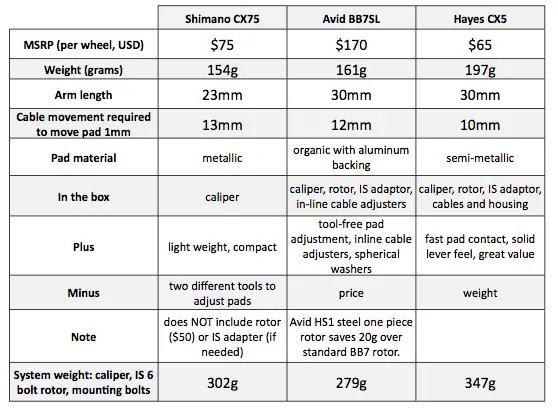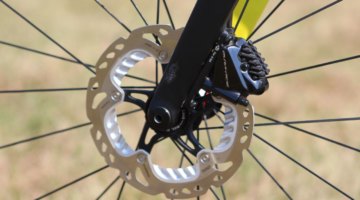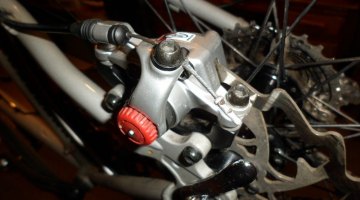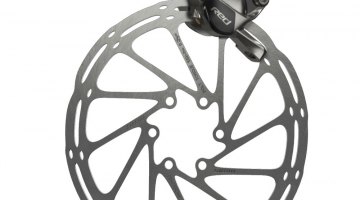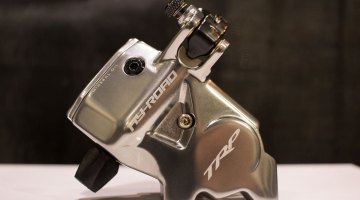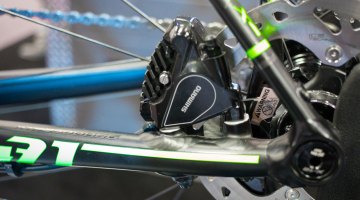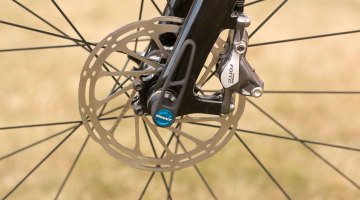With the UCI legalizing disc brakes for cyclocross, and many professionals and amateurs— particularly in the US—adopting the system, it’s no surprise to see Avid, Shimano and Hayes all release new cable-actuated mechanical brakes targeted at cyclocross racers. We’ve been testing all three brakes, the Shimano CX75, the Avid BB7 SL and the Hayes CX5, over the last few months.
I have come to appreciate mechanical disc brakes for their simplicity. Until hydraulic brake/shift levers become available, the mechanical disc brake offers a simple, effective solution, lagging only slightly in performance and weight compared to the best hydraulic systems. They are easy to set up and adjust, and they allow you to avoid the complications of hydraulic fluid and piston position. I also love the consistency, power, and modulation of disc brakes over almost any rim brake combination. Better braking allows more speed on approach, with later braking, and better control on descents.
Presently, mechanical disc brakes are single piston, meaning the outer pad moves in, but the inner pad is stationary (TRP has a dual-piston model coming that we spied in Park City at Dealer Camp). Consequently, the rotor is deflected towards the inner pad, which is slightly less efficient than dual pistons hitting the disc simultaneously. If the pad-to-rotor clearance is small, this deflection is minimal, but the user has to continually adjust the pads to keep this relationship as the pads wear.
It’s not a big deal, but it certainly requires some attention. Using a tighter clearance also means disc rub is more likely, and grit kicked up into the caliper will cause more rubbing or wear. In one extremely wet and sandy race this past season, riders with disc brakes wore through pads after one hour of racing, and we got similar reports from disc users racing the muddier days at Nationals. Those without self-adjusting hydraulic systems were forced to stop and readjust their brakes manually, losing precious time every few laps as the pads wore, or risk having no brakes at all.
That being said, the biggest advantage to discs is the relative consistency of braking. Hard, high friction pads can press against a hard, true surface that is generally out of the elements. As with all cable-actuated brakes, cable pull causes the cable housing to compress. Therefore “compressionless” cable housing and low friction cables will make a big difference in brake feel and performance for cable-actuated disc brakes. Aftermarket compressionless housing such as Yokozuna Reaction, JagWire Ripcord, or Avid’s own Flak Jacket will help eliminate a mushy brake feel, especially with the long housing lines common with disc brakes, and allow you to fully appreciate the advantage of these cable- actuated disc brakes.
Brake pads for disc brakes are most commonly seen in two varieties: resin, sometimes called organic, or metallic, sometimes called semi-metallic. Metallic pads have sintered metallic elements bonded to the pad backing. Advantages include longer wear, and better wet weather performance. Though heat dissipation is not much of a worry in cyclocross, metallic pads transfer heat to the brake caliper rather than the rotor, which can help reduce fade in hydraulic systems. Some disadvantages to metallic pads include braking noise, less initial grab and a long burnishing or break-in period to achieve full brake power.
Resin pads are comprised of organic material and fibers in a resin bonded to the pad backing. These burnish more quickly and are quieter, but transfer more heat to the rotor rather than the caliper and wear faster, especially under wet or gritty conditions. Resin/organic pads have a smooth, quiet transition as the pad hits the rotor and more lever force is applied. I like the feel of metallic pads better, but that is as much personal preference as any- thing else. All of the pads squeal when wet, and the slight, high-pitched grinding sound of a metallic pad when dry doesn’t bother me, so as long as I like the feel at the lever, a pad that wears longer is an advantage to me.
Subscribe to our All-Access Digital Magazine or order an archive copy of Issue 20 to find out Clifford’s impressions of the Shimano CX75, the Avid BB7 SL and the Hayes CX5.
Clifford Lee
Latest posts by Clifford Lee (see all)
- Bike Profile: Li King’s Singlespeed Cyclocross World Championship Winning Bike - April 15, 2024
- 2023: Cyclocross and Gravel Gear We’ve Been Loving - November 24, 2023
- Ridden andReviewed: Bombtrack Tension C Cyclocross Race Bike - September 30, 2023














